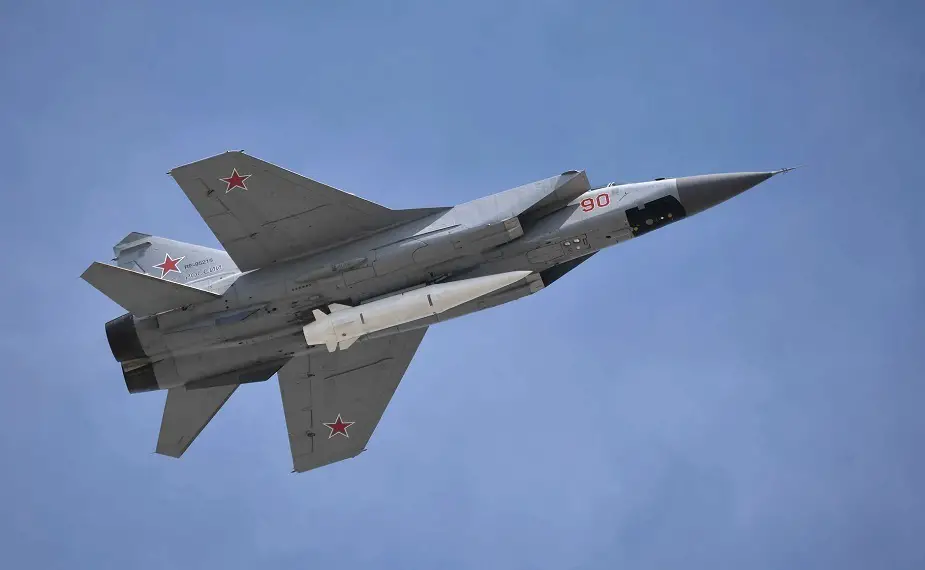Breaking news
Russian Navy preparing to accept hypersonic air ballistic Kinzhal missile into service.
The Russian Navy is preparing to accept hypersonic air ballistic Kinzhal missile into service. In particular, the naval aviation of the Northern fleet will be armed with it. The missile can hit a target with a high precision in minutes and no country has reliable defense against it, the Izvestia daily writes.
Follow Navy Recognition on Google News at this link
 A Kh-47M2 Kinzhal ALBM being carried by a Mikoyan MiG-31K interceptor (Picture source: kremlin.ru)
A Kh-47M2 Kinzhal ALBM being carried by a Mikoyan MiG-31K interceptor (Picture source: kremlin.ru)
At present, the 98th and 317th combined regiments of naval aviation of the Northern and Pacific fleets operate one squadron of MiG-31 fighter jets each. The regiments are deployed in Monchegorsk and Yelizovo airfields.
In Soviet time, MiG-31 were supplied to fighter jet regiments to replace MiG-25, Tu-128, and Su-15. The units deployed in the Kola Peninsula, Sakhalin and Kamchatka were the first to receive them.
In 1986-1989, the 865th fighter jet regiment in Yelizovo replaced Su-15 with MiG-31. In 1998, the Kamchatka flotilla, the army corps and the air defense division in the peninsula were transformed into the united command of the Russian northeastern forces of the Pacific fleet. The 865th air regiment became a naval unit. It was reduced to a squadron during the 2009 reform and currently operates in the 317th combined air regiment. The 98th regiment in Monchegorsk united several air units and received MiG-31 from the 455th regiment in Kotlas.
Thus, the Russian naval aviation received two squadrons of the fighter jets. They have been receiving upgraded MiG-31BM of late. Satellite images of Monchegorsk and Yelizovo show over two dozen parked and stored jets.
In the Cold War, Soviet generals and admirals staked on nuclear submarines and strategic bombers with antiship cruise missiles. Submarine and strategic bomber divisions had to fight convoys, aircraft-carrying and amphibious assault forces.
The long-range aviation also operated Tu-22M3. After the Soviet collapse, naval missile units were cut. Only four squadrons out of five divisions existing in 1990 were handed over to the long-range aviation in 2009. Thus, the Navy lost the missile aviation while the long-range aviation received two new air regiments.
Kinzhal has a range of 2 thousand kilometers. It is carried by upgraded MiG-31K. It is actually the first stage of the missile. MiG-31K has to deliver it to an altitude of 12-15 km. The missile is released at a high speed. Kinzhal accelerates to hypersonic speed and flies to the target by a complicated trajectory.
The combination allows the carrier to rapidly enter the launch area and destroy the target, such as a major warship and an aircraft carrier. However, MiG-31K cannot fire air-to-air missiles and has to be engaged together with MiG-31BM. It means the future regiments will comprise at least two squadrons. One will ensure air defense and protect MiG-31K. The other will operate MiG-31K.
The air regiments in Kamchatka and the Kola Peninsula can effectively operate in most of the Atlantic and Pacific Oceans against aircraft carriers and amphibious assault formations, as well as command and deployment bases of the adversary. The supplies of the aircraft to the naval aviation revives the missile aviation of the Navy at a higher technological level.
The military are first creating deployment infrastructure for the hardware and personnel and then the hardware arrives. Airfields and arsenals have been developed for Kinzhal, as well as housing for officers and men. MiG-31K will then arrive, the Izvestia said.
© Copyright 2021 TASS Navy Recognition. All rights reserved. This material may not be published, broadcast, rewritten or redistributed.



























